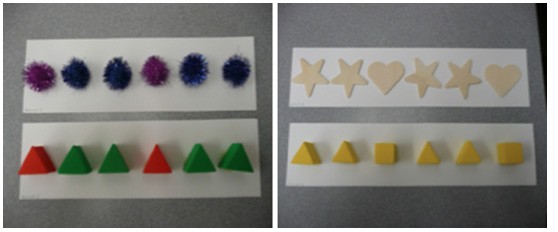At an early age, children are taught to identify and recreate patterns using objects of different colors and shapes. This seemingly simple learning activity is actually an important exercise in relational thinking, and a foundational skill in early mathematics.
According to a recent Vanderbilt study, the language used to describe a pattern—either concrete language (red-blue-red-blue) or abstract language (A-B-A-B)—makes a difference in children’s patterning skills.
Analyzing 62 Nashville preschoolers (age 4), the researchers found that children exposed to abstract (letter) labels were able to solve more pattern problems correctly than children exposed to concrete (color or shape) labels, according to Emily R. Fyfe, NSF graduate research fellow at Vanderbilt’s Peabody College of education and human development, who led the study.
“Minor differences in language can have a large effect on how children think about learning materials, including the objects that make up a pattern,” Fyfe explained. “Abstract labels can help children link concrete materials, such as blue and yellow tiles, to abstract patterns and relations (A-B-A-B). Abstract labels can also be shared across patterns. For example, the letter A can refer to a blue tile in one pattern and a green tile in a second pattern. This allows children to detect key relationships across a variety of different patterns, objects and problems.”
The findings emphasize the important role of language in the development of relational thinking and early math skills, and may provide impetus for future research on patterns in early learning settings, Fyfe said. Collaborators include Nicole M. McNeil of University of Notre Dame; and Bethany Rittle-Johnson, associate professor psychology at Peabody. The findings are published in Child Development.
If our reporting has informed or inspired you, please consider making a donation. Every contribution, no matter the size, empowers us to continue delivering accurate, engaging, and trustworthy science and medical news. Independent journalism requires time, effort, and resources—your support ensures we can keep uncovering the stories that matter most to you.
Join us in making knowledge accessible and impactful. Thank you for standing with us!

